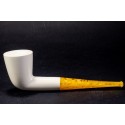Meerschaum pipes culottage
In the article on tobacco pipe run-in, we mentioned a particular phenomenon, that of meerschaum pipe culottage.
"Culottage" is a French word and is for many connoisseurs a milestone to be reached at least once in a lifetime.
Simply put, it consists of the nuanced and progressive yellowing of the meerschaum pipe, achievable with a certain smoking technique.
Before finding out how culottage occurs, one should never forget that the pleasure of smoking a meerschaum pipe is not to darken it, but to taste the tobacco.
Many smokers have lost themselves and become almost slaves to culottage, smoking solely to beautify the burner of their tobacco pipes, keeping their eyes perpetually fixed on the tobacco pipe in the hope of seeing progress in color intensity.
Appreciating the culottage of the meerschaum pipe is right, but it is absolutely useless to pursue this goal to exhaustion without enjoying the pleasure of the tobacco pipe.
History of culottage
In history there have been two very famous figures in the art of culottage, recognized as the greatest exponents of this technique: the coffee maker Teissier and the tailor Meunier, who resided in Paris around 1825.
There is a curious story concerning Tessier in particular.
It is said that there lived in Pest a Hungarian nobleman who was recognized as the best pipe smoker in his country.
Tessier's fame reached him, and it seems that the idea of having a rival in pipe smoking irritated him in no small measure, even preventing him from sleeping peacefully.
So it was that the nobleman left for Paris and, once he arrived (without even resting), asked where Tessier was, later finding him at the Café de la Bourse.
The nobleman introduced himself, saying that he was able to smoke eleven ounces of tobacco a day. For his part, Tessier replied that he smoked only five and that the smoker's virtues did not depend on the amount of tobacco.
At this point Tessier proposed to the nobleman that he smoke two identical pipes, he would smoke it for 15 days and the nobleman for 30, betting that he would still get the best culottage.
Then Tessier exhibited the culottage of some of his meerschaum pipes to the nobleman, showing near-perfect nuances he had never seen before.
The Hungarian nobleman was impressed, to say the least, by the quality of his culottages, eventually turning around and heading straight back to Pest, abandoning the venture in the bud.
Apparently following that event, in frustration, he destroyed all his tobacco pipes!
Culottage of the meerschaum pipe: how to do it
On the execution of meerschaum pipe culottage there are differing opinions.
According to Barthélemy, author of the poem "L'art de fumer, ou la pipe et le cigarette", published in Paris in 1844, he believed that an old, unburned tobacco residue should be left at the bottom of the stove, overlaying it with new tobacco with each smoke.
A contemporary of Barthélemy's, Dr. Anselmier, believed instead that this tobacco residue fermented and soured, forming liquids with a sour taste and an uneven, poor culottage.
In general, the tobacco pipe should always be cleaned after smoking, ridding it of ash and tobacco residue.
Our advice for proper culottage is to smoke slowly, with small, regular puffs.
Also, never forget that meerschaum is a delicate material: contact with wet tobacco fragments or condensation can irreparably ruin the pipe's appearance.
Precisely for this reason, soft leather, velvet or satin bags were once used to store it, so that the meerschaum pipe would always be protected, even from hand contact.
Yellowing of the meerschaum pipe occurs only in the coldest parts, that is, where condensation forms.
It thus happens that the stove, heated by the glowing embers, remains white, while the shank and the stove base tend to become colored.
If we consider meerschaum pipes depicting faces of bearded men, beautiful color effects can be achieved, with ivory-colored forehead and face, yellow-orange beard and mustache, darkening toward the shank and the part closest to the mouthpiece, creating shades ranging from red to brownish.
With some patience, colorations close to reddish-black can be achieved.
This is possible because of the wax in which the meerschaum pipes are dipped during production.
These waxes, due to heat and gravitational attraction, tend to descend toward the base of the stove.
To give you an idea of the complexity of culottage, it does not take only a few weeks or months to achieve a complete and fully satisfactory result; it can take years!
Some experienced smokers say that it takes between 20 and 30 years to reach the maximum culottage of a meerschaum pipe.
It may be, however, that those who smoke only and only one meerschaum pipe, abandoning all others, will be able to achieve a decent culottage even within two years, then after 2,000 to 3,000 smokes.
Already after smoking the meerschaum pipe a hundred times one can notice the first colorations, but there is no exact time period, because much depends on the quality of the meerschaum, the type of tobacco, its moisture and the smoking technique of the smoker.





